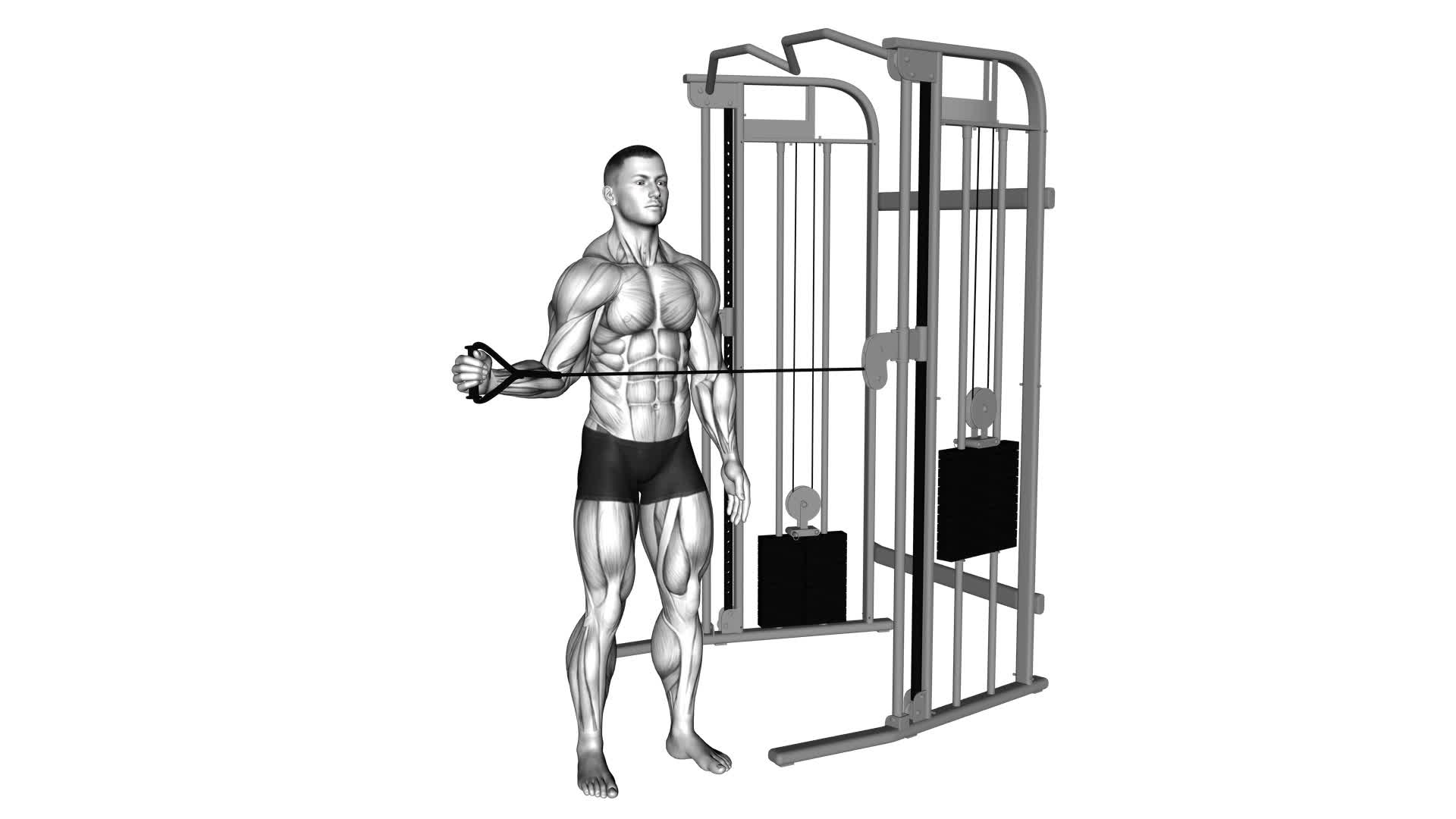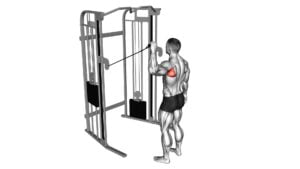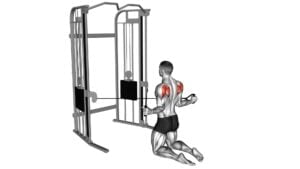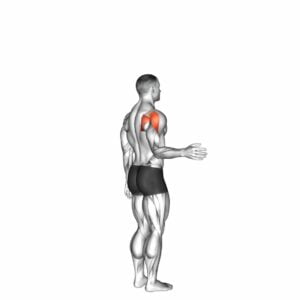Cable Standing Shoulder External Rotation – Video Exercise Guide & Tips

Looking to strengthen your shoulders? Get ready to try the cable standing shoulder external rotation exercise!
Watch This Exercise Video
In this video exercise guide, we'll show you the proper form and technique for this effective move.
You'll also discover the benefits of incorporating it into your workout routine, as well as common mistakes to avoid.
Whether you're a fitness enthusiast or a beginner, this exercise will help you build strength and stability in your shoulders.
Let's get started!
Key Takeaways
- Cable standing shoulder external rotation improves shoulder strength and stability.
- It targets the rotator cuff muscles and enhances shoulder strength, reducing the risk of injuries.
- This exercise increases shoulder mobility and stability while reducing the risk of impingement and other shoulder injuries.
- Proper form and technique, as well as choosing appropriate weight, are crucial for maximizing the effectiveness of the exercise and preventing injury.
Benefits of Cable Standing Shoulder External Rotation
You can experience improved shoulder strength and stability through performing cable standing shoulder external rotations. This exercise specifically targets your rotator cuff muscles, which play a crucial role in shoulder mobility and stability. By incorporating cable standing shoulder external rotations into your workout routine, you can effectively enhance your shoulder strength and reduce the risk of injuries.
During this exercise, you stand facing a cable machine with your arm at a 90-degree angle to your body. Grab the cable handle with your hand, keeping your elbow bent and close to your side. Slowly rotate your arm away from your body, keeping your elbow in the same position. As you rotate, you'll feel a deep stretch in your shoulder muscles.
The cable standing shoulder external rotation primarily targets the infraspinatus and teres minor muscles of the rotator cuff. These muscles are responsible for external rotation of the shoulder joint, allowing for a wide range of motion. By strengthening these muscles, you can improve your overall shoulder mobility and stability, reducing the risk of impingement and other shoulder injuries.
Incorporate cable standing shoulder external rotations into your shoulder workout routine to enhance your rotator cuff strength and improve shoulder mobility. Remember to start with a light weight and gradually increase the resistance as you become more comfortable with the exercise.
Equipment Needed for Cable Standing Shoulder External Rotation
To perform cable standing shoulder external rotations, you'll need a cable machine. This machine consists of a weight stack, pulleys, and cables that provide resistance during the exercise. The cable machine allows you to adjust the weight load according to your strength level, making it suitable for beginners and advanced individuals alike.
In addition to the cable machine, you'll also need a handle attachment. This attachment is designed specifically for shoulder exercises and provides a secure grip during the movement. The handle attachment typically has a cable clip that allows you to easily attach it to the cable machine.
When selecting the weight load for the cable standing shoulder external rotation, choose a weight that challenges you without compromising your form. It's important to maintain control throughout the movement to avoid any jerking or swinging motions.
Now that you know the equipment needed for cable standing shoulder external rotation, let's move on to the next section where we'll discuss the proper form and technique for this exercise.
Proper Form and Technique for Cable Standing Shoulder External Rotation
To perform cable standing shoulder external rotations with proper form and technique, focus on maintaining control and avoiding any jerking or swinging motions throughout the movement. This exercise is an effective cable shoulder exercise that targets the external rotators of the shoulder, improving shoulder mobility and stability. Here are some key points to consider for proper form and technique:
- Start by attaching a cable to a low pulley and standing with your side to the machine.
- Hold the handle with the arm closest to the machine, keeping your elbow bent at a 90-degree angle.
- Keep your upper arm parallel to the floor and your elbow tucked into your side.
- Initiate the movement by rotating your shoulder outward, away from your body, while keeping your forearm parallel to the floor.
- Hold the position briefly, then slowly return to the starting position.
- Remember to keep your core engaged and maintain good posture throughout the exercise.
Common Mistakes to Avoid During Cable Standing Shoulder External Rotation
When performing cable standing shoulder external rotations, it's important to be aware of common mistakes that should be avoided. By avoiding these mistakes, you can minimize the risk of injury and maximize the effectiveness of the exercise.
One common mistake to avoid is using too much weight. It's crucial to choose a weight that allows you to maintain proper form throughout the entire movement. Using excessive weight can lead to improper technique and increase the risk of shoulder strain or injury.
Another mistake to avoid is allowing your elbows to flare out during the rotation. This can place unnecessary stress on the shoulder joint and limit the effectiveness of the exercise. Instead, focus on keeping your elbows close to your body and maintaining a controlled and smooth motion.
Additionally, avoid rushing through the exercise. Performing the cable standing shoulder external rotation with proper control and range of motion is essential for targeting the muscles effectively. Take your time and ensure that you're executing the movement correctly.
Variations and Progressions for Cable Standing Shoulder External Rotation
To progress the cable standing shoulder external rotation exercise, you can try different variations and increase the resistance or range of motion. Here are three variations and progressions that you can incorporate into your routine:
- Resistance Levels: Gradually increase the weight on the cable machine to challenge your muscles and promote strength gains. Start with a lighter weight and slowly work your way up as you become more comfortable and confident with the exercise. Remember to maintain proper form and control throughout the movement.
- Stability Exercises: Incorporate stability exercises into your cable standing shoulder external rotation routine to improve shoulder stability and control. You can perform the exercise on one leg or on a balance board to challenge your balance and engage your core muscles. This variation won't only target your shoulder muscles but also enhance your overall stability and coordination.
- Range of Motion: To increase the range of motion in your shoulder external rotation, you can use a longer cable or a resistance band. This will allow you to bring your arm further away from your body, increasing the stretch and activation of the shoulder muscles. Gradually increase the range of motion over time to avoid any discomfort or strain.
Tips for Incorporating Cable Standing Shoulder External Rotation Into Your Workout Routine
As you continue to progress the cable standing shoulder external rotation exercise, incorporate these tips into your workout routine for optimal results.
When incorporating shoulder exercises into your routine, it's important to focus on strengthening the rotator cuff. The cable standing shoulder external rotation exercise specifically targets the rotator cuff muscles, which play a crucial role in stabilizing the shoulder joint.
To begin, make sure you're using the appropriate weight for this exercise. Start with a lighter weight and gradually increase the resistance as you become stronger and more comfortable with the movement. This will help prevent injury and ensure proper form.
Additionally, pay close attention to your form throughout the exercise. Keep your core engaged and your back straight. Avoid using momentum or swinging the weight, as this can take the focus away from the targeted muscles and increase the risk of injury.
Furthermore, consider incorporating this exercise into your routine two to three times a week. This will allow for proper recovery and muscle adaptation. You can perform the cable standing shoulder external rotation exercise as part of your upper body or shoulder workout, or as a standalone exercise.
By incorporating the cable standing shoulder external rotation exercise into your workout routine and following these tips, you can effectively strengthen your rotator cuff and improve shoulder stability.
Remember to always listen to your body and consult with a healthcare professional before starting any new exercise program.
Frequently Asked Questions
How Many Sets and Reps Should I Do for Cable Standing Shoulder External Rotation?
For cable standing shoulder external rotation, the number of sets and reps will vary depending on your fitness level and goals. Generally, it's recommended to start with 2-3 sets of 10-15 reps.
This exercise targets the external rotators of the shoulder, helping to strengthen and stabilize the joint. It can also improve posture and prevent injuries.
Variations of shoulder external rotation include using dumbbells or resistance bands instead of a cable machine.
Can Cable Standing Shoulder External Rotation Help Improve Shoulder Mobility?
Cable standing shoulder external rotation can significantly improve shoulder mobility. By incorporating this exercise into your routine, you can enhance the range of motion in your shoulders, making daily activities easier and reducing the risk of injury.
The benefits of cable standing shoulder external rotation include strengthening the rotator cuff muscles and improving stability. To perform this exercise, attach a cable to a low pulley, grasp the handle, and rotate your shoulder externally against the resistance.
Can I Perform Cable Standing Shoulder External Rotation if I Have a Shoulder Injury?
If you have a shoulder injury, it's important to be cautious when performing cable standing shoulder external rotation. This exercise can put stress on the injured shoulder, potentially worsening the condition.
It's recommended to consult with a healthcare professional or physical therapist for appropriate rehabilitation exercises that won't aggravate your injury. They can provide alternative shoulder exercises that will help improve mobility without causing further harm.
Is It Necessary to Use a Specific Type of Cable Machine for This Exercise?
To perform the Cable Standing Shoulder External Rotation exercise, you need a cable machine. This exercise equipment allows you to target your shoulder muscles effectively. Using a specific type of cable machine is necessary because it provides the resistance needed to strengthen your external rotators.
Ensure that the cable machine is properly set up to allow for smooth movement and proper form. This exercise can help improve shoulder stability and prevent future injuries.
Can Cable Standing Shoulder External Rotation Help With Reducing Shoulder Pain and Discomfort?
Cable standing shoulder external rotation can be beneficial for reducing shoulder pain and discomfort. By engaging the muscles in your rotator cuff, this exercise helps to improve shoulder stability and strengthen the muscles surrounding the joint.
To perform this exercise with proper form, stand with your side facing the cable machine, grasp the handle, and rotate your shoulder outward against the resistance. Remember to keep your elbow close to your body and maintain a controlled movement throughout the exercise.
Conclusion
Incorporating cable standing shoulder external rotation into your workout routine can provide numerous benefits for your shoulder strength and stability. By using proper form and technique, you can target the muscles responsible for external rotation and improve your overall shoulder function.
Avoiding common mistakes and progressing with variations can help you maximize the effectiveness of this exercise. With the right equipment and dedication, cable standing shoulder external rotation can be a valuable addition to your fitness routine.

Author
Years ago, the spark of my life’s passion ignited in my mind the moment I stepped into the local gym for the first time. The inaugural bead of perspiration, the initial endeavor, the very first surge of endorphins, and a sense of pride that washed over me post-workout marked the beginning of my deep-seated interest in strength sports, fitness, and sports nutrition. This very curiosity blossomed rapidly into a profound fascination, propelling me to earn a Master’s degree in Physical Education from the Academy of Physical Education in Krakow, followed by a Sports Manager diploma from the Jagiellonian University. My journey of growth led me to gain more specialized qualifications, such as being a certified personal trainer with a focus on sports dietetics, a lifeguard, and an instructor for wellness and corrective gymnastics. Theoretical knowledge paired seamlessly with practical experience, reinforcing my belief that the transformation of individuals under my guidance was also a reflection of my personal growth. This belief holds true even today. Each day, I strive to push the boundaries and explore new realms. These realms gently elevate me to greater heights. The unique combination of passion for my field and the continuous quest for growth fuels my drive to break new ground.







